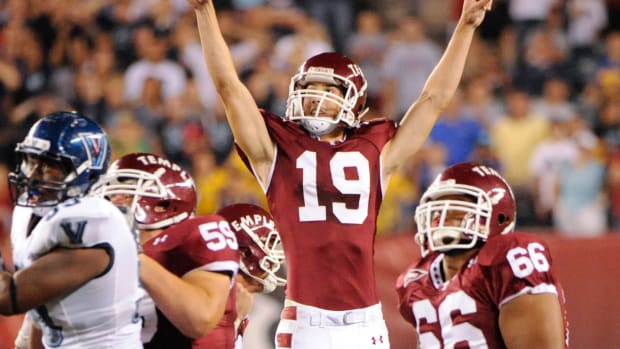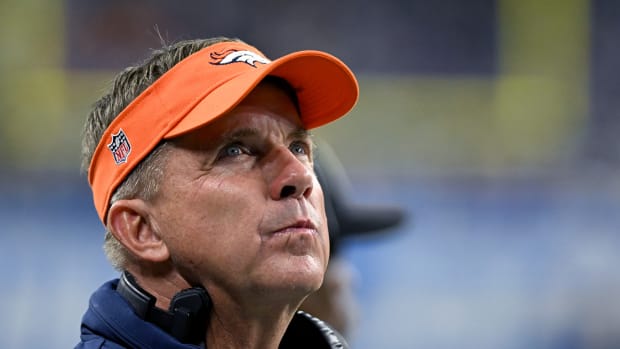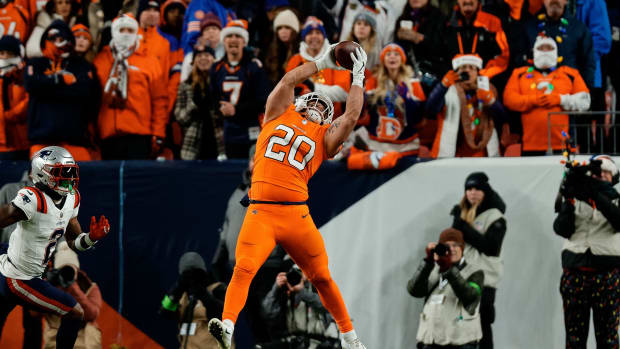NFL.com Analytics Expert Explains Why OLB Nik Bonitto was a Value Pick for Broncos
With the 64th pick in the 2022 NFL draft, the Denver Broncos selected Oklahoma's electric quick-twitch pass rusher Nik Bonitto. While the Big 12 is not known for being a conference that develops many standout defensive prospects, in Alex Grinch’s 3-3-5 defense, Bonitto flashed the burst, bend, and tenacity any team wanting to improve its ability to rush the quarterback would covet.
One of the media's analytics experts is NFL Network's Cynthia Frelund. In her recurring segment on NFL.com called Game Theory, Freland’s models project Bonitto as one of the better value picks made on Day 2.
Bonitto ranked 51st on my big board ahead of the 2022 draft, but now that he's paired with Bradley Chubb and the Broncos defense, the forecasted production value is significantly higher than the league average I used to create my values. PFF gave Bonitto a 94.6 pass rush grade over the 2020 and 2021 seasons combined, the highest in the FBS (Aidan Hutchinson was second). Last season, the former Sooner was also PFF's highest-rated edge player in pass-rush win rate (27.8%) and had the highest QB pressure percentage among Power Five players (19.8%). Computer vision shows that his second-contact win rate (when a defender is stopped by an offensive lineman and then attacks again) was third-best among all draft-eligible edge defenders last year.
Models and analytics are very useful tools in today’s NFL. Given how often Broncos’ GM George Paton praised his analytics department in helping to guide the front office in a lot of Denver's offseason decision-making, it’s perhaps not surprising that a player that tended to appear more favorably for those touting analytics ended up being the team's first pick in the draft.
Bonitto’s exact fit in an NFL defense does take some imagination. While he played a stand-up, rush-the-passer-from-the-edge role, along with delayed blitzes after looping to the middle of the offensive line, dropping into coverage, and sliding over into a quarterback spy, the slant-based front of Oklahoma’s defense is unlike any currently being deployed in the NFL.
Bonitto's run defense assignments aren't easy to project, but his ability to close ground and pursue the quarterback is obvious as soon as one puts on the tape. Given the value of the passing game and just how consistently he rushed the passer in college, it’s no wonder that the more analytically-based models praise the Broncos for the selection.
What makes analytics in this instance extremely hard to reckon with is that at the college level specifically, the styles of play and differing levels of talent across different conferences can alter outputs and findings in models rather drastically. While Oklahoma used a 3-3-5 defense with a slant-based front that favored its front seven players shooting a single gap and penetrating, rather than the more read-and-react defensive rush approach that is far more prevalent in prominent college football conferences and at the NFL level, just how Bonitto was used and how many reps translate to tasks and assignments he will be asked to do on Sundays is not a one-for-one comparison.
Instead of having to rush the passer while also maintaining gap integrity, Bonitto and the rest of the Sooners’ defensive front were tasked with pinning their ears back and shooting upfield to disrupt in the backfield. Disruption is production, but this kind of defensive structure is not as widely used in the NFL due to the vastly improved quarterback play compared to the college level, the difference in field dimensions (in the college game, the hash marks are further apart creating more of a space game versus that of the NFL game), and how the lighter box/two-high safety defenses have put far more of the onus on the defensive front to not only rush the passer, but control multiple gaps across the front in the run game at the same time.
With Bonitto’s specific role in an exotic (by NFL standards) style of defense in a conference that arguably is the second least=-talented in the Power 5 in college football (sorry PAC-12), the analytics are not nearly as standardized comparing Denver's second-round pick to the type of football and assignments tasked to other edge rushers from differing conferences.
Bonitto’s traits and how he wins are obvious on tape. He is slippery, he possesses a great get-off from the snap, he's relentless in his pursuit, can close space in a hurry, and his ability to bend around the arc to get after the passer are all top-notch and the very reason he was drafted at 64 despite questions on his tape. That’s the reality of taking a premium position such as edge at pick 64. Any player at that position taken that far from the top of the draft will have questions and limitations to their game.
Much like former Broncos’ 2015 first-round pick Shane Ray coming out of Missouri, Bonitto won a lot of his projectable pass rush reps from a wide-9 alignment and simply beat Big 12 offensive tackles to the edge and around the arc. That is a valuable trait, but it’s not enough to believe Bonitto will blossom into a defensive player as impactful as models using his play at Oklahoma are projecting.
Just as Paton and defensive coordinator Ejiro Evero stated on the phone to Bonitto as soon as he was drafted, the former Sooner is going to need to work on adding mass to his frame and strength to his game to become a more well-rounded player. Year 1 just being a sub-package designated pass rusher will be more than fine for where Denver selected Bonitto in the draft.
However, unless Boniotto works on diversifying how he can win in his pass rush, adding the power to the speed-to-power conversion that is coveted in the league and not being a detriment on run downs while still getting after the quarterback, don’t expect him to become a quality edge able to play all three downs immediately. What he brings to the table is more than fine for the 64th pick.
Pass rushing is and will always be at a premium. However, until Bonitto adds more of a power element to his game, his upside as a full-blown starting edge will remain limited in the current landscape of how teams are combatting the modern-day offense.
Follow Nick on Twitter @NickKendellMHH.
Follow Mile High Huddle on Twitter and Facebook.
Subscribe to Mile High Huddle on YouTube for daily Broncos live-stream podcasts!





